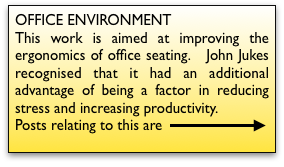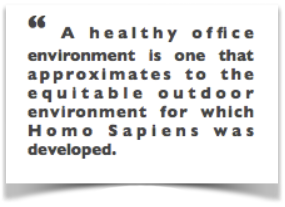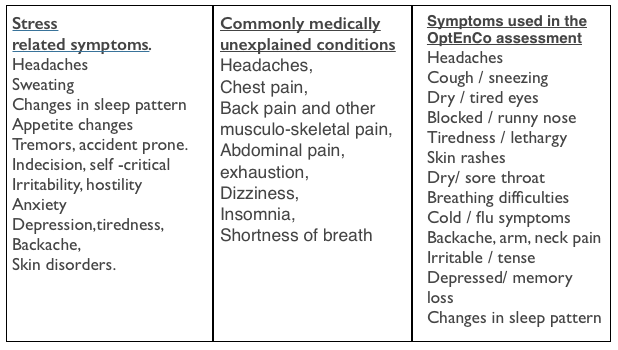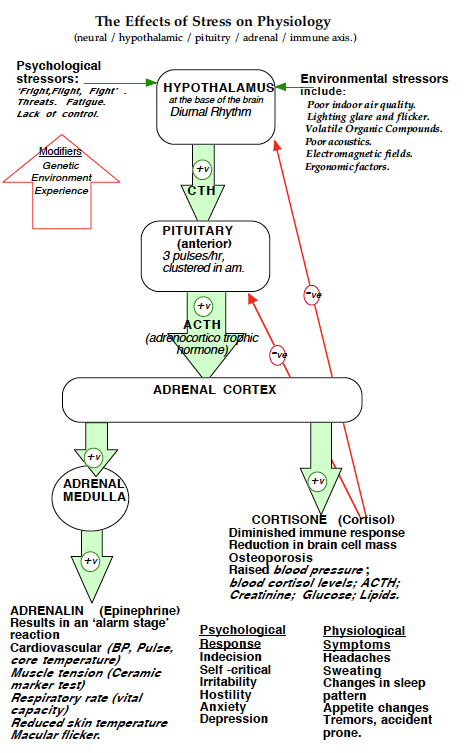Article published in EurOhs, European Occupational Health and Safety Journal, Dec 2002.by Dr HA Sanford, MA, MB, BChir (Cantab), DPhys Med (Lond) Chief Medical Officer to OptEnCo.
 Chairs and workstations are a relevant factor in office environment optimisation. The bigger picture is described here. Written in 2002, some of the comments are somewhat dated. However the main thrust is frustratingly slow in entering the mainstream of office design.
Chairs and workstations are a relevant factor in office environment optimisation. The bigger picture is described here. Written in 2002, some of the comments are somewhat dated. However the main thrust is frustratingly slow in entering the mainstream of office design.
Summary
Hitherto stress related illness has been thought to be due to psychogenic causes associated with changes in commercial practice. More recently it has been recognised that adverse indoor physical environmental factors actually account for the bulk of stressors in the office and work environment. These potentiate the minor morbidity (illness) and the more overt psychosomatic expression. Environmental stressors can be identified, quantified and relatively easily corrected. When addressed up to 40% increase in productivity is permanently achieved.
Introduction
Recently I saw a patient with a severely painful neck which was threatening his highly paid job which was in a ‘dealing room’ type office. He shared a single height worktop with eight others. He had to lean forwards to speak into a microphone and not only view a VDU screen but also look over his shoulder to check a wall display. Luckily a modification of these conditions and a cervical facet joint injection cleared his symptoms to his own relief and that of his firm which was foreseeing expensive litigation.
As a doctor working in the field of musculo-skeletal disorders I am never ceased to be surprised to see patients who are highly paid and work in prestigious firms but physiologically inadequate environments. The poor ergonomic facilities result in a musculo-skeletal breakdown and in addition they usually have symptoms of stress. As they are well paid they often do not wish to confront the management with their problems, and may even try to keep them secret. Departments, such as editorial in the newspaper industry, may have a macho philosophy which extends to their expert workforce who are proud to grit their teeth and carry on in these adverse conditions. The breakdown, when it comes, is complete.
Costs
Ergonomic factors account for only a part of the physiological stressors that occur in offices which account for a wide spectrum of ‘stress related’ conditions. These have been listed in the U.S. by the Environment Protection Agency (EPA) and the National Institute of Occupational Safety and Health (NIOSH). This burgeoning rate of so called ‘stress related’ illness represents inadequate adaptation of mankind from a huntergatherer lifestyle to one of an indoor, sedentary and emotionally stressful occupation. In the UK, Health & Safety Executive (HSE) figures show that 1 in 11 of the work force suffer occupational health problems. 750,000 people are involved and equals some 1.3 million days of production lost each year. 270, 000 people daily take a day off work. The cost to the UK is £7 billion a year.
- Actual costs to individual firms are considerably more than these figures would suggest. Firstly these figures represent only the tip of an iceberg when considering the vast number of people suffering from minor symptoms. These are regarded as a part of normal working life and then ignored and not reported, although this minor morbidity undermines the efficiency and productivity of the individual, and results in a reduction in overall company performance. This decrease may go undetected by management if work task efficiency has not been measured systematically. This 18% to 52% reduction implies that 18-52% of staff are being employed to make up the shortfall.
- Secondly, illness and stress result in increased churn rates which carry extra costs to a firm. Replacement of a bank clerk costs £5000, and up to £50,000 to replace an Inland Revenue Inspector. `(in 2002)
- Thirdly, in the UK, there were 164,000 claims for stress-related conditions in 1999- 2000, an increase of almost a third on the previous year. Litigation damages can be spectacular and in addition to these costs, media coverage of litigation results in damage to a firm’s reputation. It should also be remembered that under both HSE and pending EEC legislation management will have not only a civil but also a criminal liability.
- The pressures of recession are adding to the ethos of business management which has resulted in ‘downsizing’ of the workforce which creates extra demands on surviving staff and added to long hours spent in a physiologically unfriendly environment, gives rise to anxiety, fatigue and to high levels of morbidity and breakdown. This led John Monks, General Secretary of the TUC, to refer at the Congress in September 2000 that the an estimated £23 billion of unpaid overtime was resulting in ‘burnout Britain’.
Medical considerations
A consideration of the medical background show that three broadly overlapping and ill-defined medical conditions have been described.
- The first ‘stress related’ illness is generally regarded as a psychological response to anxiety and fatigue leading to a number of symptoms and even serious breakdown and illness.
- The second is of more interest to doctors (not to mention their patients). As many as one in five new2 consultations in medical primary care fail to identify a recognised organic medical condition. These include chest, back and abdominal pain; exhaustion, headaches, dizziness, insomnia, shortness of breathe – to name only a few. Some prove to be transient; about 10-15% are shown to have an organic cause; some have an unrecognised organic cause – but most have symptoms that persist and are never explained in spite of appropriate investigation. A confusing terminology has developed around this poorly understood group. The most exact and nonjudgmentalis ‘medically unexplained symptoms’ which many feel to be too unspecific. ‘Psychosomatic illness’ implies that psychogenic conditions results in a physical illness and ‘somatisation’ suggests a psychogenic condition which is expressed in physical symptoms. Some patients may have overt psychiatric disorders such as anxiety, depression or a phobic personality. Most have a complex mix of aetiological factors , biological, psychological, social and cultural.
- The third, consisting of symptomatology associated with the environmental physiological stressors, may be the most important and is usually ignored. In the last five years a simple standardised assessment has been developed for symptoms and environmental satisfaction and been related to a number of adverse parameters in the physical environment by OptEnCo in conjunction with Reading, University3 . A baseline normal has been established and it has found for 30,000 office workers in 300 buildings in the UK, USA and Europe that 80% of these workers experience excessive symptoms due to various physical stressors in the officeenvironment4 . The top (worst) score is 20 and this can be permanently reduced to 2-0 if environmental stressors are eliminated. An average unimproved modern office environment scores about 6 and a score of 12 shows a definite negative environmental impact on staff. The three syndromes are tabulated here :-
Stressors and physiological reaction
The common factors are a mix of adverse or threatening environmental condition which result in stimulation of neuro-humeral mechanisms mediated through the hypothalamic-pituitary-adrenal axis which result in a widespread physiological response. Stressors initiates a neuro-humeral cascade which finally affects the whole body. In the acute phase threatening environmental stressors result in the ’fright, flight, fight’ response. In evolutionary terms these are an important survival mechanism. In modern office conditions they can be the reverse.
Physiological (environmental) stressors
Stressors, in addition to excess temperature and humidity variations and ergonomically incorrect furniture, include less obvious environmental components.
- Acoustics. Office equipment generate saw-tooth sounds which in nature are used by animals as aggressive warning signals and square wave sounds which are used for identification. Both cause alarm and are likely to be stressors in humans. At high and prolonged level, noise is rare in nature but poor acoustics in an office leads to raised voices, distraction and increased measurable levels of stress hormones.
- Lighting by ordinary fluorescent tubes may appear white, but actually only emit light mainly in a narrow band at the yellow end of the spectrum. Only some 8% of the photo-receptors in the retina are stimulated (as compared to 79% in daylight). Added to this, and because of the ‘omni-directional’ nature of the light, some 25% of the light is lost as ‘glare’ – that is, light striking the eye directly and containing no visual information. A 52 cycle ‘flicker’ (in UK) is caused by the conventional ballast of fluorescent tubes. Refresh rate is detected by the eye although not registered by the conscious mind. In addition This rate interacts with that of the VDU screen (at 60-70 cps). This produces an even more deleterious flicker effect.
- Micro-climatic conditions in most offices are equivalent to the stressful conditions that occur before a thunderstorm or during prolonged desert winds due to the positive ionisation caused by electrical and electromagnetic (EMF) emissions from the multiplicity of machines in the modern office.
- Chemical and particulate pollutants are potentially pathogenic, and are therefore stressors. These are in low concentration in nature and easily dispersed by air currents or denatured by ultra violet light. The high levels found in industrial society are even higher in an enclosed office space where some are being produced. Toxic Volatile Organic Compounds (VOCs) are produced by new carpets and furniture. Viruses, bacteria, moulds and their spores are provided with ideal culture habitats and also dispersal systems through inadequate air conditioning. Computers and in particular CRTs create microparticles of carbon derived from incinerated shed squame skin cells. These can penetrate the lining epithelium of the lungs and blood vessels and are thought to have an effect on the autoimmune system.
Acute phase response
The immediate effect of stress is on the hypothalamus which lies in the base of the brain near the brainstem. The hypothalamus produces corticotrophin hormone (CTH) diurnally in small amounts but when stimulated produces a large amount which is carried by its private blood circulation to the pituitary gland which lies nearby under the brain. The pituitary also produces small doses of hormone, adrenocorticotrophic hormone (ACTH), about 3 pulses an hour clustered in the morning, and on stimulation by CTH liberates a large dose into the general, systemic, blood circulation. This, in turn, stimulates the paired adrenal glands, which sit like a cap above the kidneys, to produce adrenalin (epinephrine) from the adrenal medulla. In the acute phase adrenalin has an immediate effect with a feeling of fright, increased respiratory and pulse rate and blood pressure, cold and pale skin. In nature this would be resolved quickly by fright, fight, flight or oblivion.
Chronic phase response
Under modern conditions the stress usually is not resolved and persists to become chronic. Under these circumstances a further humeral cascade occurs with a release of cortisone (cortisol), a glucocorticoid with a normal daily output 10-20 mgms, by the adrenal cortex. This is intended to damp down the effects of the initial CTH and ACTH and return the body to normal. If the stress is not resolved then the excess cortisone exerts its corticotrophin effects which include immune-suppression, reduction in brain cell mass; raised blood pressure; raised blood cortisol, creatinine, glucose and lipid levels. A chronically raised cortisol level can also give rise to emotional disorders such as panic attacks, free floating anxiety and depression with a link to eating disorders, addictions and other compulsive disorders, 5 which are likely to be wrongly attributed to immediate psychological stressors. These changes can result eventually in cardiovascular disease, accelerated ageing, diabetes. Immune system suppression results in infections and peptic ulceration. A number of modifiers account for the variations in response to stress. These include genetic disposition, previous experience or learnt coping strategies. A number of physiological tests are available to asses stress. These include those for the Cardiovascular system (Blood Pressure; Pulse; core temperature), for Muscle tension (Ceramic marker test); Respiratory rate (vital capacity); Reduced skin temperature; Macular flicker and estimations of blood cortisone levels. It will be noticed that these include plathysmograph, or ‘lie detector’, readings which detects the stress which may be occasioned by lying.
Psychological v Environmental stress
Psychological stress arises from anxiety due to a variety of causes including fear of redundancy, lack of control of the work in hand and interpersonal conflicts. These stressors are immediately evident and therefore given undue prominence by the individual and industry which has responded by commanding a large literature and a bewildering array of stress management strategies. More basic evidence shows that, on the contrary, these are not of prime importance. A prevailing view that “it’s all in the mind’ has been equated to asserting that the world is flat. Although environmental stressors, such as air quality, light and noise, are more aetiologically significant, operating on a more basic physio-pathogenic level, they are less easily identified by the individual, than psychological stress and have therefore been largely ignored. An unexpected finding following office Although environmental stressors, such as air quality, light and noise, are more aetiologically significant, operating on a more basic physio-pathogenic level, they are less easily identified by the individual, than psychological stress and have therefore been largely ignored. An unexpected finding following office environmental optimisation that the 80% decrease of symptoms also included those recognised as due to emotional ‘stress’. This suggests that once the physical stressors are removed or reduced the individual can respond effectively to psychological stress and overall symptoms are reduced. The evidence of breakdown is by a common psychosomatic pathway which exhibits itself to the clinician, therapist or management and is taken at face value. If physical environmental stressors, over prolonged periods, can potentiate the effects of psychological stress leading to overt symptomatology then it is to be expected that treatment aimed only at the psychological stress will be ineffective or benefits will be temporary. This, in practice, is what is found.
Solutions
The combination of stressors and pathogens such as VOCs and microorganisms in the indoor workplace result in lowered productivity and alertness with the litany of minor everyday symptoms such as headaches, backache, RSI, skin disorders, sore throats, palpitations,asthma (COPD), tiredness and depression, tired and itchy eyes which have already been listed. These can lead on to more serious conditions. The practical implications are encouraging. Physical environmental stressors can be identified, assessed and measured so that effective measures can be introduced to correct them. These measures are simple, precise and produce a pleasant and stimulating workplace, with increased productivity, at no great cost. The cost of a full optimisation is about £5000 for each workstation and less if incorporated in a new development. This cost is recuperated in less than 3 years by increased productivity. Paradoxically, the power position of employer and employee may be naturally reversing. Employees of high skill and competence are likely to regard firms as a mere commodity. Already highly rewarded financially, they will look for and expect a pleasant, healthy and stress-free environment. Firms will have to provide this if they are to attract and keep the high quality tech-savvy, workers required for a first world economy. Some US firms have preempted this by providing a high-quality environment on the grounds that they have the best staff in the world and in order to optimise their performance they are given the best possible working conditions, expense being of little relevance. City firms are also experiencing difficulty in recruiting and retaining top professionals. There is a culture among modern executives to enrich their careers by moving on, usually within 18 to 24 months. Only 19% state that money is the main reason for change, the prime motivation being challenge and excitement. Better working conditions are also seen as important and staff are becoming increasingly better informed on environmental issues. In addition to the standard measures adopted in occupational Health, environmental optimisation becomes a basic requirement to retain staff the loss of which in the modern knowledge led economy is probably one of the most serious losses that a competitive business can suffer. In times of recession costs to a firm of morbidity resulting in absence from work, lowered day to day productivity, increased churn rate and litigation is of serious concern and may not besustainable. The only strategy to reducecosts without a reduction of productivity islikely to be environmental optimisation.
References
- 1 Sunday Times 25/3/01.London
- 2 Clements-Croome, Professor DJ et al. An Assessment of the Influence of the Indoor Environmenton the Productivity of Occupants in Offices. 1998. Dept of Construction Engineering and Management, University of Reading.
- 3Jukes J., Optimising the Design of the Workplace for Better Productivity and Health. Workplace Comfort Forum, London.1997
- 4 NIOSH
The physiologic background
- OFFICE STRESS & Backache→

- ☛ Jukes. Managing the Ergonomics →
- ☛ PRODUCTIVITY AND WORKPLACE STRESSORS→ (Article published in EurOhs, European Occupational Health and Safety Journal, Dec 2002.by Dr HA Sanford)
- ☛ HAS, on ☛ Office health (& RSI)→ Only a lighthearted account.
- ☛ The OFFICE 2 Tilt chair →
- ☛ 4M OFFICE WORK-STATION→
- ☛ SLEEP & productivity



